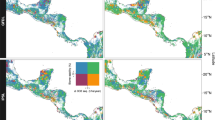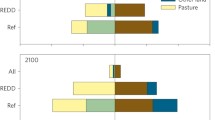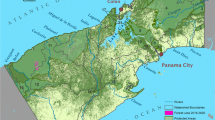Abstract
This paper explores the economic feasibility of secondary forest regeneration and conservation as an alternative in the campaign addressing the problem of global warming. Detailed measurements of tropical secondary forests over time, in different ecological zones of Costa Rica, are used to evaluate carbon storage models. The paper addresses key issues in the international discussion about cross- and within-country compensation for carbon storage services and illustrates a method to compute/predict their economic value over time under a variety of scenarios. The procedure is applicable to other developing countries where secondary forest growth is increasingly important.
Similar content being viewed by others
References
Andrasko, K. (1990), El recalentamiento del globo terráqueo y los bosques: estado actual de los conocimientos. FAOConference on Climate Change, Rome Italy.
Andersen, L.E. (1996), A Cost Benefit Analysis of Deforestation in the Brazilian Amazon.Department of Economics, University of Aarhus, Denmark.
Brown, S., A. Gillespi and A. Lugo (1989), ‘Biomass Estimation Methodsfor Tropical Forests with Applications to Forest Inventory Data’, Forest Science 35, 881–902.
Brown, K. and N. Adger (1993), ‘Forests for International Off-Sets: Economic and Political Issues of Carbon Sequestration’, CSERG Working paper, Center for Social and Economic Research on the Global Environment, Univ. of East Anglia and Univ. College of London.
Carranza, C. (1996), ‘Valoración (SINAC)’,Centro Científico Tropical (CCT).
Corporación de Fomento Ganadero (CORFOGA) (1995), El subsector de ganadería de came en CostaRica. Documento para discusión, San José, Costa Rica.
Fankhauser, S. and R. Tol (1996), ‘Climate Change Costs. Recent Advancements inthe Economic Assessment of Climate Change Costs’, Energy Policy 24(7), 665–673.
Fearnside, P. and W. Malheiros (1996), ‘Carbon Uptake by Secondary Forests in the Brazilian Amazonia’, Forest Ecology and Management 80, 35–46.
Houghton, R. A.,D. L. Skole and D. S. Lefkowitz (1991), ‘Changes in the Landscape of Latin America: Net Release of CO2 to the Atmosphere’, Forest Ecology and Man 38, 173–199.
Judge, G. G., W. E. Griffiths, R. Carter Hill, H. Lutkepohl and Tsoung-Chao Lee (1985), TheTheory and Practice of Econometrics. New York: John Wiley & Sons, Inc.
Kaimowitz, D. (1995), Cattle Ranching Expansion andSecondary Forest in Central America IICA. San José, Costa Rica.
Ministerio de Ambiente y Energía (MINAE), Ley Forestal No. 7575, Alcance No.21 a la Gaceta No. 72 del 16 abril de 1996. San José, Costa Rica.
Oficina de Implementación Conjunta de Costa Rica (OCIC) (1995), Notas Técnicas.San José, Costa Rica.
Ramirez, O. A. and M. Gómez (1998), Factibilidad Económica del Uso de la Tierra en Plantaciones forestales, Manejode Bosques Naturales y Café Orgánico-Ecológico en America Central. CCAD-USAID PROARCA/CAPAS Project Report, June, 143 p.
Ramirez, O. A. and M. Gómez (1999), ‘Estimación y valoraión económica del almacenamiento de carbono’, Revista ForestalCentroamericana 27, 17–22.
Ramirez, O. A., B. Finnegan, L. Rodriguez and R. Ortiz (1999), ‘Evaluación económica delservicio ambiental de almacenamiento de carbono: el caso de un bosque hÚmedo tropical bajo diferentes estrategias de manejo’, in J. A. Dixon, L. F. Scura, R. A. Carpenter and P.B. Sherman, eds., Análisis Economico de Impactos Ambientales, pp. 212–224.
Richards, F. J. (1959), ‘A Flexile Growth Function for Empirical Use’, J. Exp. Bot. 10(29), 290–300.
Schroeder, P. E., R. K. Dixon and J.K. Winjum (1993), ‘Ordenación forestal y agrosilvicultura para reducir el dióxido de carbono atmosférico’, Unasylva 173(44).
Solórzano, R., R. de Camino, R. Woodward, J. Tossi, V. Watson, A. Vásquez, C. Villalobos and J. Jiménez (1991), ‘La depreciación delos recursos naturales en Costa Rica y su relación con el sistema de cuentas nacionales’, Centro Científico Tropical (CCT) and World Resources Institute (WRI). San José, Costa Rica.
SRC International Pty Ltd. Benefits and Costs of Joint implementation and the Clean DevelopmentMechanism for Australian Industry. Prepared for International Greenhouse Partnerships Office, Melbourne (1999). (http://www/isr.gov.au/resources/energy_greenhouse/igp/srcfinal.pdf as of February 3, 2001).
Tol, R. S. J. (1999), ‘The Marginal Costs ofGreenhouse Gas Emissions’, Energy Journal 20(1), 61–81.
United Nations Framework Convention on Climate Change. TheConvention and Kyoto Protocol (http://www.unfccc.de/resource/convkp.html, as of February 2, 2001a).
United Nations FrameworkConvention on Climate Change. Mechanisms Pursuant to Articles 6, 12 and 17 of the Kyoto Protocol: Text by the Chairman, Addendum, Article 12 of the Kyoto Protocol (http://www.unfccc.int/resource/docs/2000/sb/10a02.pdf as of February 2, 2001b).
Watson, R. T., I. R. Noble, B. Bolin, N. H. Ravindranath, D. J. Verardo, and D. J. Dokken (2000), IPCC Special Report on Land Use, Land-Use Change and Forestry. Intergovernmental Panel on Climate Change (http://www.usgcrp.gov/ipcc/SRs/land_use/index.htm as of February 1, 2001).
Author information
Authors and Affiliations
Rights and permissions
About this article
Cite this article
Ramirez, O.A., Carpio, C.E., Ortiz, R. et al. Economic Value of the Carbon Sink Services of Tropical Secondary Forests and Its Management Implications. Environmental and Resource Economics 21, 23–46 (2002). https://doi.org/10.1023/A:1014533310664
Issue Date:
DOI: https://doi.org/10.1023/A:1014533310664




